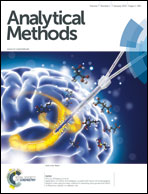Trace copper ion detection by the suppressed decolorization of chromotrope 2R complex†
Abstract
Chromotrope 2R (CR) is a monoazo dye, which can be easily degraded under ultraviolet C (UVC) light irradiation. However, the degradation extent of CR is suppressed after it is chelated with Cu2+ ions to form a coordination complex (Cu2+–CR). This phenomenon was developed as a novel method for the quantitative detection of Cu2+ ions, which is based on determining the change in absorbance (ΔA, the absorbance of Cu2+–CR complex subtracted by that of CR after UVC light irradiation) by UV-visible absorption spectrum. Under the optimal detection conditions, ΔA at 509 nm highly depends on the concentration of Cu2+ ions in the range from 5.0 × 10−9 to 1.0 × 10−6 M as expressed by the following equation: ΔA = 0.3066 + 0.03605 lg c with the correlation coefficient of r = 0.9912. The limit of detection (ld) is 3.4 nM as calculated by the formula 3σ = 0.3066 + 0.03605 lg ld. This method provides affordable and selective detection of Cu2+ ions and was used to detect Cu2+ ions in a human hair sample.


 Please wait while we load your content...
Please wait while we load your content...